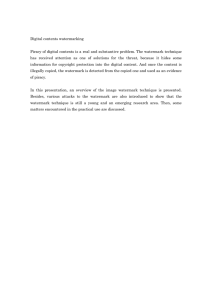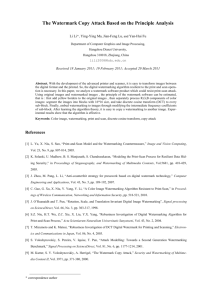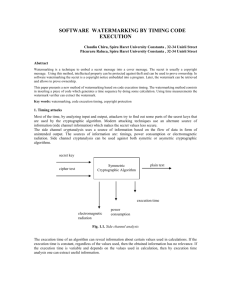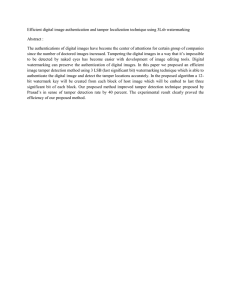By developing computer usage specially ... performance many other fields have ... CHAPTER 1
advertisement
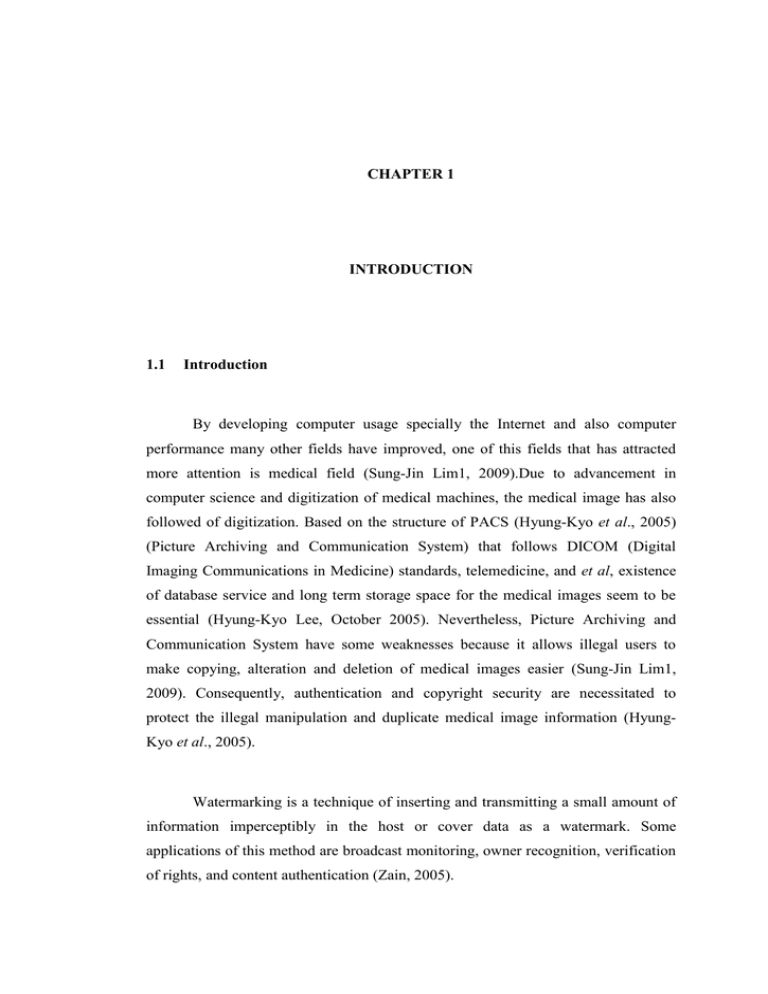
CHAPTER 1 INTRODUCTION 1.1 Introduction By developing computer usage specially the Internet and also computer performance many other fields have improved, one of this fields that has attracted more attention is medical field (Sung-Jin Lim1, 2009).Due to advancement in computer science and digitization of medical machines, the medical image has also followed of digitization. Based on the structure of PACS (Hyung-Kyo et al., 2005) (Picture Archiving and Communication System) that follows DICOM (Digital Imaging Communications in Medicine) standards, telemedicine, and et al, existence of database service and long term storage space for the medical images seem to be essential (Hyung-Kyo Lee, October 2005). Nevertheless, Picture Archiving and Communication System have some weaknesses because it allows illegal users to make copying, alteration and deletion of medical images easier (Sung-Jin Lim1, 2009). Consequently, authentication and copyright security are necessitated to protect the illegal manipulation and duplicate medical image information (HyungKyo et al., 2005). Watermarking is a technique of inserting and transmitting a small amount of information imperceptibly in the host or cover data as a watermark. Some applications of this method are broadcast monitoring, owner recognition, verification of rights, and content authentication (Zain, 2005). 2 Therefore, watermarking techniques used to support the medical images in the medical field (Sung-Jin Lim1, 2009). One of the advantages of digital watermarking is that the authentication data is straightly implanted into the image data. So, the authentication information stays alive even if the host image is manipulated (Zain, 2005) based on how watermarks are embedded, exist three categories of watermarking: Robust, Fragile and Semi-Fragile Watermarking. Robust watermarks are complicated to remove from the digital objects. These kinds of watermarks are able to resist against deliberate or non-deliberate changes same as cropping, scaling, A/D (Analogue to Digital) or D/A (Digital to Analogue) conversion, filtering, compression, etc. because of these features, robust technique is useful for exclusive rights and ownership recognition applications. On the contrary, fragile or semi-fragile watermarks are mostly implemented in content authentication and integrity verification because they are weak against attacks; fragile watermarks are easily damaged by manipulating or modification of the watermarked object so this kind of watermarking should be sensitive to all type of modifications. Semifragile watermarks usually survive in non-deliberate and incidental attacks and therefore are destroyed against malicious manipulate. Commonly, semi-fragile watermarks should satisfy three fundamental necessities: high sensitive against deliberate tampering and strong to the operation of content security, imperceptible and secure. Semi-fragile watermarking have not only to be sensitive to on purpose attacks, but also robust to conventional image processes for example JPEG compression, noise addition, etc. So, it can make a distinction among deliberate and non-malicious attacks (Memon et al., 2009a; S. Radharani and Valarmathi, 2010; Xiangqing et al., 2009). Another categorize of watermarking is based on where watermarks are inserted (S.J. Lim et al., 2009). According to this classification digital image watermarking can be embedded in the spatial domain or in the transform domain. (Shun-liao and Zheng-bing, 2009). In spatial domain, the watermark is straightly implanted in the host object to modify it. Nevertheless, in transform domain, at the first step by using of some kind of transformation same as Discrete Cosine Transform (DCT), Discrete Fourier Transform (DFT), Discrete Wavelet Transform (DWT) and etc., the main image is converted to frequency domain and in the next 3 step watermark is inserted into it. These days majority of the researchers implemented different sort of transform domains in their methods instead of spatial domain because the spatial domain is sensitive to modification (Megalingam et al., 2010). Another class of watermarking which is most significant in medical image is based on region of interest (ROI) or region of non-interest (RONI), this classification is due to reduce the mistakes of diagnosis in medical field. ROI contains the most significant information which the doctors focus more on this region and their decision is relied on this portion. Thus, obviously the watermarking process should not influence the ROI because damaged ROI will lead to incorrect diagnosis and big mistake. So for solving this problem it is better to embed the watermark into the RONI (Memon, 2010). 1.2 Background of the Problem PACS can develop the medical services when collecting medical coverage is serious and also need for speed to treatment. Nevertheless, Picture Archiving and Communication System has some weaknesses because it allows illegal users to make copying, alteration and deletion of medical images easier. In addition, for archiving and transmit the medical images which contain vast of information, the compression is one of the most significant image processing (S.J. Lim et al., 2009). In the other hand HIS (Hospital Information System) like PACS makes easy access to manipulate, and distribute medical information. Though, unlawful duplicate of medical image, possession rights and information authentication are the common problems in PACS and HIS (Hyung-Kyo et al., 2005). 4 In information hiding algorithms, if the hiding algorithm just applies for concealing the secret information, it may be available by using of some special algorithms after extraction (Hua et al., 2010). The designed method by Verma, et al. (2006) was completely robust against some ordinary image processing operations, same as filtering, scaling and rotation; but they are less strong against cropping attack because the bits of watermark are inserted into the whole parts of host image so during cropping some information must be gone. The previous data hiding techniques which were designed by majority of researchers like as Wakatani (2002), Giakoumaki et al. (2003), C.S. Woo et al. (2005) and Rodriquez et al. (2007) have one common problem. In all of them the main image is unavoidably distorted during inserting data and it cannot be removed fully because of quantization, bit-replacement, or truncation. Even though distortion is tiny and most of perceptual models are tried to reduce its visibility, totally because of legal reasons the distortion is not acceptable for remedial images (Memon et al., 2009b) Van Schyndel et al. (1994) proposed a technique which is robust to little amount of noise and can contain more than one watermark because msequences’ different segments are unassociated. In their method by manipulating the least significant bit (LSB) the watermark can be removed or exchanged with no trouble. Additionally, their scheme has weak localization properties. New watermarking schemes researches are content-based oriented. Most of them are relied on Human Visual System (HVS) and using Just Noticeable Distortion (JND) for selecting the position of watermark information. ICA (Independent Component Analysis) is a novel method that is more used for copyright protection. Its problem is that in this method for doing well copyright protection a huge amount of information about the host image is required to extraction phase that are created unnaturally (S. Radharani and Valarmathi, 2010). 5 Some numerical and perceptual errors maybe happen in an image during watermark embedding. “The greater the robustness of a watermark, the greater the errors are likely to be”. As a result medical image watermarking assign a vast open area for studying about it to itself, and obviously the suitable solution for common problem is selection the best watermarks among different kind of them for different sort of medical image type (Planitz and Maeder, 2005). The research of Huangand Chiang (2005) that based on spatial domain, the watermark is inserted to the DC (direct saturation Adjustment) elements of color image straightly. The outcome demonstrated that their algorithm provided robust performance for most image processes apart from images with high frequency components which attacked by rotate and scaling processes (Ibrahim Nasiret al., 2007;Barniet al., 2006). 1.3 Statement of the Problem Medical image watermarking should be satisfied the below questions: 1. How we can embed a watermark into medical images which looks imperceptible? 2. How we can achieve to the best properties of watermarking like robustness, invisibility and security? 3. How we can Specify RONI and ROI in mammogram images? Unfortunately center of attention of several researches are on LSB algorithm so the least significant bit (the 8th bit-plane) are employed for inserting watermark bit stream. Despite the replacement algorithms of LSB are uncomplicated and invisible but they are not robust. The LSBs are high frequency components so malicious or non-malicious tampering and replacement are done with no difficulty. 6 In the majority type of digital objects, imperceptible watermarking is so appropriate “to be treated as an IP rights protection” system. Readers cannot distinguish the variation between imperceptible watermarked objects and the main one, unless watermark extraction processes are applied (Chun-Hsiang and Ja-Ling, 2004). Accordingly the major drawback in digital watermarking schemes is the use of LSB for embedding watermark in spatial domain and extraction processes for unseen result (Bedi and Verma, 2006). Embedding and detecting phases in spatial domain are uncomplicated than the watermarking in transform domain. The main benefit of watermarking in spatial domain is the low computation difficulty when is judged against domain transforms techniques watermarking in spatial domain doesn't cause change in the image quality, it guarantees a high imperceptibility but makes low robustness to a number of attacks (Larijani and Rad, 2008; F. Mintzer et al., 1998). But it's in danger to compression, zoom-in and zoom-out and when this happens, it's not possible to distinguish watermarks to look after the copyright or possession of the digital objects (Sung-Jin Lim1, 2009). Both domains were represented to different watermarking attacks. Though the techniques which are applied in spatial domain is not robust to several attacks but it will give inadequate information to the attackers unless attackers have the cracking key (Riaz et al., 2008). 1.4 Aim of dissertation The aim of this dissertation is to implementation a multiple semi-blind ISB watermarking algorithm which based on robust watermarking scheme in spatial domain and analysis the best quality of watermark properties such as robustness, imperceptibility and capacity in Medical images. 7 1.5 Objectives of the Study To answer the problem statement, following objectives of this project are shown as below: 1. To implement a novel multiple semi-blind ISB watermarking algorithm for mammogram images. 2. To evaluate the visual imperceptibility and robustness of the proposed algorithm by using PSNR metric and NCC metric against adding noise, applying Filters and some geometric and non-geometric attacks. 1.6 3. To specify RONI and ROI parts in mammogram Image. 4. To develop medical image watermarking in spatial domain. Scope of the Study The focus of this study is on the following aspects 1. The suggested algorithm worked in spatial domain (Two level of ISB bit-plane) 2. The proposed method focused on 648×1024 pixels of the grayscale mammogram image and the format is TIFF. 3. A grayscale watermark image with five different size and TIFF format used in the experiments to test proposed technique efficiency 4. Kind of attack which are applied on suggested algorithm are noise addition attacks, Filter attacks, Motion attacks, Geometric attacks and Contrast enhancement attack. 5. The program is built on Macintosh environment using MATLAB 2012 language and the images prepared by using Adobe Photoshop CS5. 6. Dataset: 50 images obtained from (http://rad.usuhs.edu/medpix/) 8 1.7 Significance of the study In most watermarking methods, the host image is modified and maybe destroyed during the embedding authentication data. In many watermarking purposes, while the main image and the watermarked one are perceptually the same, losing the loyalty of image is not prohibitive (Zain, 2005). In watermarking authentication the measure of invisibility and also robustness of ordinary image processing are the two essential components. The robustness means that after some malicious attacks that main goals of them is just remove or make the watermark recoverable and non-malicious attacks are those kinds of attacks that occur during the normal use of asset or image processing the watermark information is able to be detected or extracted from manipulated image. Therefore it is clear that the embedding phase in the watermarking process play an essential role for getting high robustness performance (YING JUN et al., 2011). In contrast, authentication play a significant role in some fields same as medical, armed forces and justice system imaging applications and keep the fidelity of original image in these applications are so noticeable. Thus any permanent changing or manipulating in the main image is restricted. For example, any modifying in a patients' image may cause a big mistake in diagnosis process and this error cause to wrong cure and life-threatening effects (Zain, 2005). These days by the fast enhancement in communication technology and computer systems, medical images transfer among hospitals has become a hot issue. Transferring medical images between health centers happen due to the a lot of reasons for instant teleconferences from one hospital to another one, interdisciplinary exchange among doctors and radiologists for consultative reasons or to argue about diagnosis and remedial measures and for therapeutic personnel remote studying (N. A. Memon and Gilani, 2008) for these reasons medical Image information need to strict safety, privacy, reliability and integrity when exchanged among hospitals. Archiving to these requirements need to implement some procedures which provide 9 image quality and privacy of patients’ information against illegal readers (Memon et al., 2009b). PACS that is short form of the Picture Archiving and Communication System were launched for medical system digitalization and telemedicine among the health centers. By introducing PACS the medical images creation, archiving, and exchange are achievable. There has been a growing interest in protecting medical images with an enormous amount of information. To improve transmission speed among the hospitals, the medical image should be compression by high compression ratio (Sung-Jin Lim1, 2009). 1.8 Dissertation organization This research consists of five chapters. The first chapter presents introduction to the project which includes the problem background, problem statements, aim of project, the main objectives and scope of the project. In the chapter 2 covers information about literature review on medical image watermarking, which focused on current algorithms that have been using for embedding watermark in medical images. The project methodology is discussed in Chapter 3 where comparative study and pre-lab testing have been used as the research strategy. In Chapter 4, the implementation of the methodology where the findings of comparative study and pre-lab testing take place and eventually, in Chapter five the result and findings of the lab testing is explained and the overall project will conclude as well.

